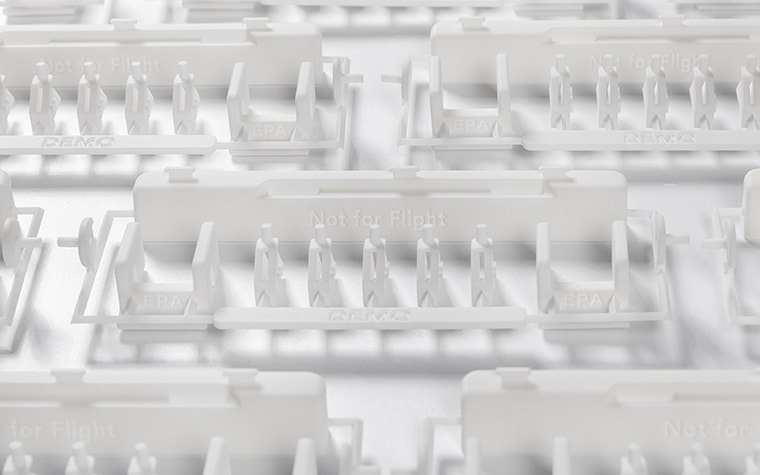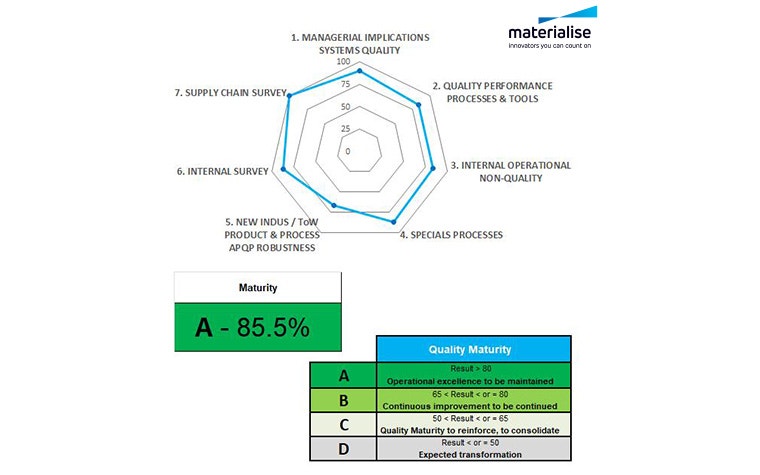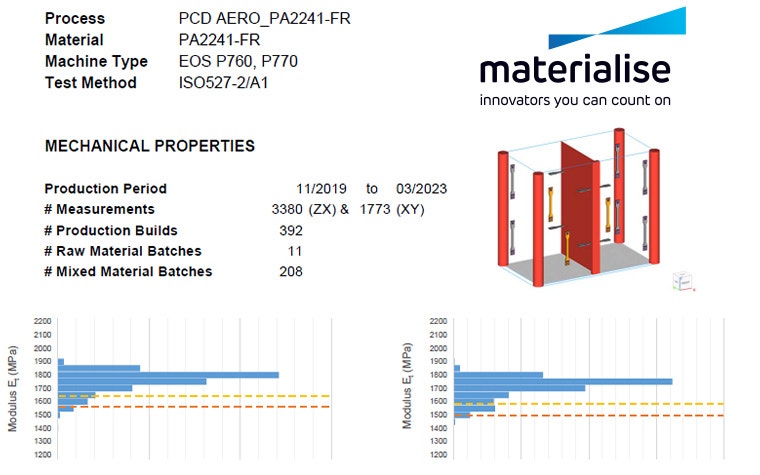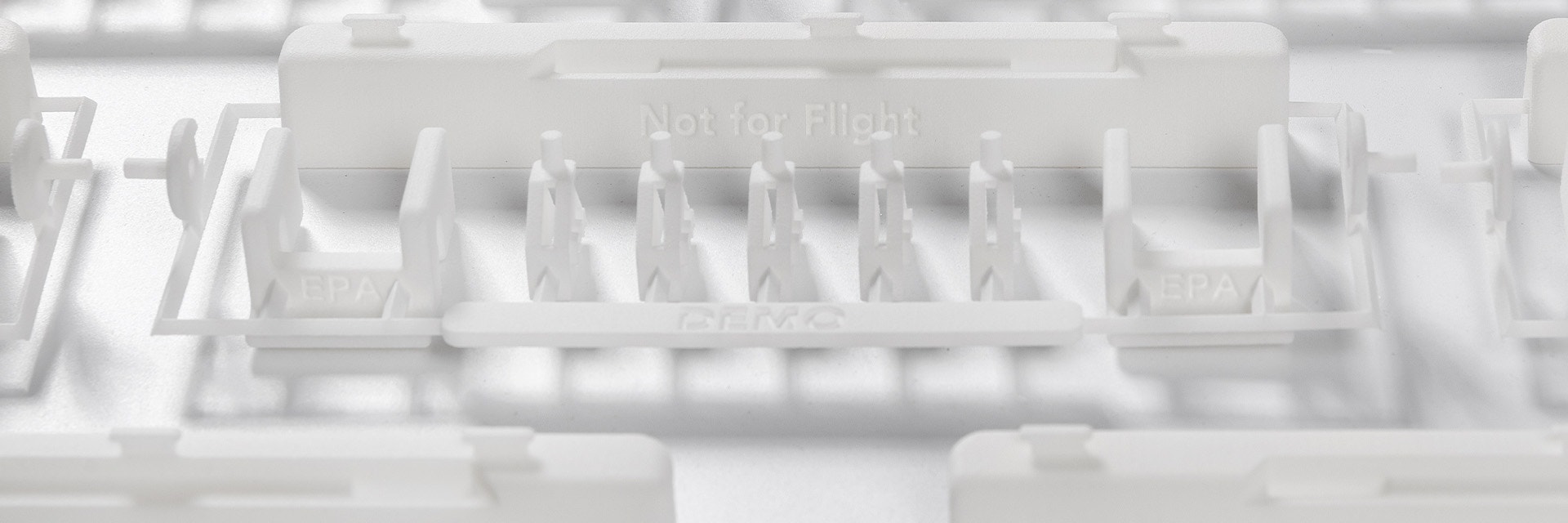
INTERVIEW
EASA 21.G, EN 9100, and Additive Manufacturing: How Materialise Sets the Standard for AM in Aerospace
Gert Brabants, Business Line Manager of Series Manufacturing, and Erik de Zeeuw, Market Manager for Aerospace, have helped additive manufacturing become a mature, trusted technology in the aerospace industry. It’s a journey built on data, process control, impeccable standards, and collaboration with aviation partners and authorities.
Manufacturing for aerospace is incredibly demanding in terms of quality. What does Materialise do to meet those expectations?
Gert Brabants: When we talk about quality in our aerospace processes, it really boils down to three different parts: the quality before we start, the quality during the process, and the quality afterward.
Let’s start at the beginning, then. What happens first?
Gert Brabants: The quality before we start is the NPI — the new product introduction — where we make a very detailed assessment of the part’s risks and the specifications we’ll put against them. It gives us a thorough understanding of what our customers need.
Whenever we begin a project, the discussion starts with; “We have these new parts; these are the requirements and the risks we identified. How can we deal with those?”
How does that translate into process control?
Gert Brabants: Once those risks are addressed and properly managed during the process, we can talk about process control. This largely involves monitoring witness samples during the process to verify that our processes are stable and under control.
Take PA-FR, for example; we built 15 witness samples solely for tensile testing just to see if our processes meet all the requirements. But on top of that, we check the density, the dimensional accuracy, the visual quality, and other things like powder hardness to make sure the process itself is stable.
The final step is all about quality assurance. What happens once the part is manufactured?
Gert Brabants: After printing, our quality control operators visually inspect the part to ensure there are no defects. We’ll also make all the necessary documentation: first article inspection (FAI) reports, test reports on aspects like the color of painted parts, and validate the mechanical properties of the build on which the parts are built to ensure they meet all the requirements.
Is there much difference between this approach for aerospace and other industries?
Gert Brabants: We follow the same NPI process for all industries. Beyond that though, our aerospace processes are much more strictly controlled because of the needs and regulations of the industry — everything from the number of witness samples we check to the incoming goods inspection, the quality of the material, and the strictness of the process itself has to meet these very specific standards.
We've also developed our quality control process to match these requirements; we have a dedicated team and unique standards for aerospace, there are specific checks and controls, and a different defect catalog. We know this system works, so we aim to apply it to other materials that need this level of control and quality in industries like medtech.
Where does that extra control come from? Is it driven by our aerospace customers?
Erik de Zeeuw: Safety in aviation is the top priority, so it’s driven mostly by the regulators and partially also by Airbus as a customer — their size and influence make them something of a regulator in their own right. That level of regulation is very rarely seen in other industries.
We’ve spoken to you both before about how our standards help address issues of trust in additive manufacturing and (a lack of) standardization — has that moved forward in recent years?
Gert Brabants: We still share our own standards; the margins our processes work with, the allowable limits for material characteristics, and so on. They're often shared as an example within the industry, and accepted in the absence of something like an ISO standard. We created this process control document to prove our processes are under control, frozen, and stable — it's very well received by our customers.
I think standardization today is still largely focused on what to control, not exactly how to control it. For example, they may say you need to check the raw material properties of the powder you receive but not specify which limits to use, how frequently to check it, or how best to do so. They’ll just say to make sure you have a check in place.
Why do you think that is?
Erik de Zeeuw: There are two reasons, I would say. On the one hand, standardization organizations don’t want to control everything — they don’t want to create audit traps with their standards, and they want companies to be flexible when interpreting what is required. However, there are also fields that have not yet been identified.
The number of standards has grown steadily over the last few years across the whole product chain of additive manufacturing: machine setup, the training of employees, powder preparation, and those kinds of things, but they’re focused more on metal than polymers. That’s why we are still pushing our standards forward and working closely with groups like EASA and Nadcap.
What role does Materialise play there when working with aviation authorities like EASA?
Gert Brabants: We’re involved in the discussions and working groups for the certification of low-criticality parts as well as the certification bodies. In that sense, we're also in the driving seat when it comes to new requirements and how to meet them.
What we’ve done so far with EASA and the FAA working groups is discuss what certification for low-criticality parts should look like. We also presented our cases with our allowables approach and how we tackle the challenge of certification to the major industry partners, including Airbus, Boeing, and the European and American authorities. It gives us a voice in how we see this evolving and lets us keep a close eye on where it’s going — we won't have a large gap to close if something changes or if we move in a certain direction.
You mentioned working on standardization with Airbus directly. What did that process look like?
Gert Brabants: Erik and I were both involved with Airbus when it came to setting up the fused deposition modeling (FDM) and selective laser sintering (SLS) processes. We obviously learned a lot from that, and we also apply it for all our aerospace customers. I think in terms of process standards, Airbus has some of the most detailed around.
We were particularly involved when it came to SLS. There was a real collaboration where we shared our knowledge of the process and worked with them to fix and write down a process specification based on our combined experience. We were actively involved in defining how this should work and be controlled.
As an EASA-certified POA, Materialise has worked with those standards for around 10 years now. Safe to say they’re achievable?
Erik de Zeeuw: Absolutely — it’s the day-to-day business for us. We’ve done it for hundreds of thousands of parts. We rigorously attend to those standards, and that’s the reason for our success and the trust our customers have in additive manufacturing with Materialise. I have the feeling that every time we’re audited, they appreciate this way of working.
That’s reflected in the result Materialise had on Airbus' Quality Maturity Assessment. What does that A-grade mean?
Erik de Zeeuw: It’s an assessment of how the backbone of our quality management system works and how we manage our operations. So, it goes beyond just adhering to the standards and looks at our maturity as a manufacturing organization.
Gert Brabants: Exactly. It’s not specifically about the quality of the parts we deliver but the overall setup — how we control the processes and our delivery performance. Do we deliver on time? Do we have many quality complaints, and how do we deal with them? How do we solve issues, follow up, and improve over time?
We’re also regularly audited on the process qualifications for FDM and SLS. Every two years, Airbus comes to specifically check whether everything is in order with the SLS process. Based on that, they define the gaps and any actions we need to take. All these things together ensure we continuously deliver quality parts and keep improving where needed.


Our supply chain scored particularly highly. Why is that?
Gert Brabants: On one hand, it's relatively simple — for most parts, the bill of materials is only raw material, sometimes paint or minor assemblies. On the other hand, we work closely with our suppliers — R&D projects, improvements, basic business development. We have an excellent connection.
I’d also like to highlight our score on the special processes because that’s really about qualifying and monitoring the technology; how we make sure the output of those processes is robust and repeatable.
Despite that clear progress, many still consider repeatability to be an issue for additive manufacturing in aerospace. Why is that, and how can we build that trust?
Gert Brabants: I think it’s because there's not a lot of standardization or accessible data; you can’t find online databases of material properties for additive manufacturing. They're all quite limited and specific. The only way to create that trust with our aerospace customers is by showing them the data.
We have a very extensive database because we worked for so long with one of our OEM partners on FDM and SLS: 15 data points per build produced in PA-FR, and we started producing PA-FR specifically for that partner five years ago, but for aerospace in general already before that. We can prove that our processes are consistent and reliable.
We share this data freely with the aerospace industry. What makes that so valuable?
Gert Brabants: For aerospace companies, qualification is essentially proof that the process is good enough, but to prove it, you need to collect data points — that’s expensive. They can run some tests on one, two, or three builds to prove the material properties are good, but it's a significant investment for the customer, and it gives a very limited view of the process. It's a very specific picture of the process in time that does not indicate what the performance of that process will be in one or two years.
Our data shows we could reach the same quality five years ago as we did two years ago, and we’ll be able to do it next year as well. That's the big value. This is the type of data our customers need if we want them to trust additive manufacturing — whether it’s reliability, convincing the decision-makers, or just clearing the financial hurdle of testing to help them get started.
Erik de Zeeuw: We also need to recognize its relevance to the authorities. They realize that the technology is process-intensive, which means that the properties are defined during printing, not the raw materials. That’s why we need tight process control and data that really comes from the place producing the parts, not just what the machine manufacturer says it can obtain. Real performance data and deducted allowables1 are important because they are proof of our process control, prove that we’ve mastered the process in our production, and show our customers what they can expect from the products they intend to purchase.


Beyond repeatability, is there still a lack of awareness of what’s possible with additive manufacturing?
Erik de Zeeuw: More a lack of awareness around the level additive manufacturing has reached, I’d say. There are multiple examples showing it works for end-use parts, but some of the people we speak to are surprised that it’s so advanced in the field of aerospace with this level of maturity.
Gert Brabants: Also, you can’t underestimate how long change can take in this industry. For the past ten years, we have delivered FDM parts to Airbus; parts that used to be machined are now 3D printed. Airbus used these parts to build their knowledge of 3D printing and gain the supply chain benefit of ordering small quantities.
Now, we're starting to see more and more cases with Airbus where we really talk together about design optimization and integrating several parts — the areas where additive manufacturing can really excel.
What does an aerospace company have to do to shift from traditional to additive manufacturing for flying parts?
Gert Brabants: To put it in context, we produce over 26,000 parts for the A350 ecosystem every year. It’s Airbus’ newest aircraft, and it had no 3D-printed parts at the beginning. That's a big effort on their part.
Introducing 3D-printed parts comes with a lot of recertification costs, so the easiest way to do that today is still to switch the manufacturing method, one by one. You don't touch the design or need to prove that your design has changed. You just need to prove that the production technology doesn't introduce any new failure modes.
Suppose an aerospace company wants to redesign a part from scratch and really go for weight optimization and bionic designs. In that case, they’d also need to prove that the new design is as good as the previous design, which makes the process a lot more complex. The positive news is that Airbus is looking to go down that road more and more, because they see the benefits of designing for additive manufacturing. They have the knowledge from years of producing the straightforward parts, but they really need to identify the right cases, work out the business cases, and then find the right applications.
Erik de Zeeuw: It’s an approach that both we and the authorities recommend to anyone looking to adopt additive manufacturing in aerospace: take it step-by-step, and don’t immediately start working on high-criticality parts. Take the time to get accustomed to the technology, start with easy, low-criticality parts with conventional designs, and then progress to more advanced designs and more critical applications.
Materialise has EN 9100 certification for both polymer and metal parts — will we see a similar approach with metal 3D printing?
Erik de Zeeuw: It's already happening, though at a slower pace. Of course, the certification effort is grander, and more requirements need to be assessed, but we’re working hard to make it happen, as are aircraft manufacturing companies.
1 Allowables are used in the design and validation of aircraft, and are necessary for the certification of aircraft structures by the FAA. They are created by applying factors of safety to the design, and are based on standardized test plans and statistical techniques.
Share on:

Biography
Gert Brabants, Business Line Manager, Series Manufacturing, Materialise

Biography
Erik de Zeeuw, Market Manager Aerospace, Materialise
You might also like
Never miss a story like this. Get curated content delivered straight to your inbox.
